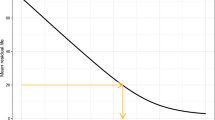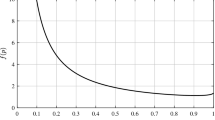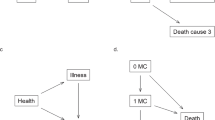Abstract
Standard methods for estimating the effect of a time-varying exposure on survival may be biased in the presence of time-dependent confounders themselves affected by prior exposure. This problem can be overcome by inverse probability weighted estimation of Marginal Structural Cox Models (Cox MSM), g-estimation of Structural Nested Accelerated Failure Time Models (SNAFTM) and g-estimation of Structural Nested Cumulative Failure Time Models (SNCFTM). In this paper, we describe a data generation mechanism that approximately satisfies a Cox MSM, an SNAFTM and an SNCFTM. Besides providing a procedure for data simulation, our formal description of a data generation mechanism that satisfies all three models allows one to assess the relative advantages and disadvantages of each modeling approach. A simulation study is also presented to compare effect estimates across the three models.
Similar content being viewed by others
References
Cox DR, Oakes D (1984) Analysis of survival data. Chapman and Hall, London
Hernán MA, Brumback B, Robins JM (2000) Marginal structural models to estimate the causal effect of zidovudine on the survival of HIV-positive men. Epidemiology 11(5): 561–570
Hernán MA, Hernández-Diáz S, Robins JM (2004) A structural approach to selection bias. Epidemiology 15: 615–625
Hernán MA, Cole SR, Margolick J, Cohen M, Robins JM (2005) Structural accelerated failure time models for survival analysis in studies with time-varying treatments. Pharmacoepidemiol Drug Safety 14(7): 477–491
Page J, Hernán MA, Robins JM (2008) Structural nested cumulative failure time models. Tech. Rep., Department of Epidemiology, Harvard School of Public Health
Picciotto S, Young J, Hernán MA (2008) G-estimation of structural nested cumulative failure time models. Am J Epidemiol 167(Suppl): S139
Picciotto S, Robins JM, Young J, Hernán MA (2009) Estimating absolute risks under hypothetical interventions using a structural nested cumulative failure time model. Am J Epidemiol 169(Suppl): S34
Robins JM (1986) A new approach to causal inference in mortality studies with a sustained exposure period: application to the healthy worker survivor effect. Math Model 7: 1393–1512
Robins JM (1998a) Marginal structural models. In: 1997 proceedings of the American statistical association, section on Bayesian statistical science, American Statistical Association, pp 1–10
Robins JM (1998b) Structural nested failure time models. In: Armitage P, Colton T (eds) Encyclopedia of biostatistics. Wiley, Chichester, pp 4372–4389
Robins JM, Hernán MA (2009) Estimation of the causal effects of time-varying exposures. In: Fitzmaurice G, Davidian M, Verbeke G, Molenberghs G (eds) Advances in longitudinal data analysis. Chapman and Hall/CRC Press, Boca Raton, pp 553–599
Robins JM, Blevins D, Ritter G, Wulfsohn M (1992) G-estimation of the effect of prophylaxis therapy for pneumocystis carinii pneumonia on the survival of AIDS patients. Epidemiology 3: 319–336
Robins JM, Blevins D, Ritter G, Wulfsohn M (1993) Errata to g-estimation of the effect of prophylaxis therapy for pneumocystis carinii pneumonia on the survival of AIDS patients. Epidemiology 4: 189
van der Laan MJ, Robins JM (2002) Unified methods for censored longitudinal data and causality. Springer, New York
Young JG, Hernán MA, Picciotto S, Robins JM (2008) Simulation from structural survival models under complex time-varying data structures. In: JSM proceedings, section on statistics in epidemiology. American Statistical Association, Denver, CO
Author information
Authors and Affiliations
Corresponding author
Rights and permissions
About this article
Cite this article
Young, J.G., Hernán, M.A., Picciotto, S. et al. Relation between three classes of structural models for the effect of a time-varying exposure on survival. Lifetime Data Anal 16, 71–84 (2010). https://doi.org/10.1007/s10985-009-9135-3
Received:
Accepted:
Published:
Issue Date:
DOI: https://doi.org/10.1007/s10985-009-9135-3




